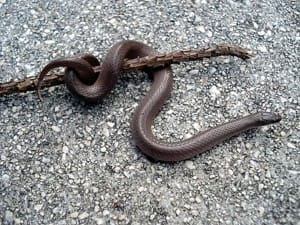Source(s): Michael T. Mengak
No other creatures provoke such simultaneous conflicting feelings as do snakes. We are at once attracted and repelled, intrigued by them and their habits and, at the same time, certain people are seized by an almost overwhelming urge to kill. As with any wild animal, caution is advised. Homeowners, hikers, hunters, children and others should not approach or threaten any wild animal, and snakes are no exception.
A major reason many fear snakes is that some are venomous. Of the more than 50 kinds in Georgia, however, only 6 species or about 12 percent are venomous. Our venomous species are Eastern Coral Snake (Micrurus fulvius), Copperhead (Agkistrodon contortrix), Cottonmouth (Agkistrodon piscivorus), Pygmy Rattlesnake (Sistrurus miliarus), Timber Rattlesnake (Crotalus horridus), and Eastern Diamondback Rattlesnake (Crotalus adamanteus).
Fortunately, snakebite is a rare accident. Fewer people are killed by snakes than by lightning. The best defense is knowledge; learn to recognize venomous species. Snakes of Georgia and South Carolina by Whit Gibbons and Patricia West (editors) is a good reference for snake identification. This booklet is available for $5 from the Savannah River Ecology Laboratory in Aiken, SC, the University of Georgia Cooperative Extension Service or your local county extension agent.
Snakes feed on a wide variety of small creatures and are very particular about what they eat. Some species eat only warm-blooded animals such as rodents and birds. Others may eat only toads and frogs. Large land-dwelling snakes are likely to feed on rodents, birds and their eggs, lizards, other snakes, toads and frogs. Aquatic snakes feed primarily on fish and amphibians. Small snakes are likely to eat mice, frogs, toads, earthworms, slugs and soft-bodied insects. Thus snakes are part of the natural system. Many of the things they eat are considered pests, so knowledgeable people spare harmless snakes that live in their yards.
Venomous snakes are another matter. In most circumstances, they should be removed. Be careful – a snake can strike half its length or more. Even when the snake is dead, its reflex movement can result in a bite if handled carelessly. Bites by venomous snakes need prompt medical attention. The bites of non-venomous species can be treated with soap, water and antiseptic.
Any non-venomous snake can be safely removed from a building by using a long-handled broom to gently brush the animal into an empty trash can. Place the lid on the can and take the snake to a wooded area away from any homes and carefully release it.
Refer venomous snakes in buildings to the Wildlife Resources Division of the Department of Natural Resources. Most people are bitten when they try to kill a snake. This only causes the snake to defend itself the only way it can.
The following plan of action will reduce the severity of a snake bite:
- Stay calm. The snake may be non-venomous, but if it’s venomous, excitement hurts, not helps.
- Have someone kill the snake so it can be identified. Use extreme caution. Most snakebites occur when attempting to kill the snake.
- Get to competent medical help as quickly as possible.
- Ask your doctor what he or she advises regarding snake bite – before it happens.
What attracts snakes to dwellings? If the house is surrounded by natural countryside with rock piles, streams and swamps nearby, snakes will appear from time to time. Naturalistic landscaping, rock gardens, weedy places, piles of boards and debris, deteriorating outbuildings and other similar things may harbor snakes.
Since there are no chemical poisons or effective repellents registered for snake control, the best way to make yards and outbuildings unattractive to snakes is to clean up and clean out. Snakes cannot hear sound, so auditory repellents are ineffective.
The first step is to ensure that there are no openings in dwellings or other structures where snakes can enter. Since snakes can get through very small holes (about the size of a dime), a careful inspection is necessary. For additional information, check with your local county extension office.
At the same time you are keeping snakes out of the house, take steps to make the rest of the premises unattractive. Look at the surroundings as if you were a snake. Are there rodents or other sources of food? Are there places to hide? If the answers are “yes,” plan a program to remove food and cover.
- Control rodents if they are present.
- Get rid of debris.
- Remove brush and leaf piles.
- Place stacked materials 12 or more inches above the ground or floor and away from walls.
- Keep the space beneath structures and stacks clean.
- Keep shrubbery and other plantings away from foundations and walls.
- Keep shrubbery clean and free of debris. Keep lawns closely mowed. Fill unwanted depressions.
- Keep stream or pond banks clean and clipped.
These practices will reduce but not eliminate the possibility of finding snakes. Remember, it is best to remove items that a snake would find attractive. Do not try to handle them.
Enjoy their presence by observing them from a safe distance. They are highly evolved predators that have a natural role in the environment. Especially remember that the vast majority are secretive, harmless to humans and beneficial in controlling mice, insects and other pests.
Center Publication Number: 212
- Evaluating Attractants for Live-Trapping Armadillos - September 23, 2013
- Snakes and Their Control - September 23, 2013
- Copperheads - September 22, 2013
